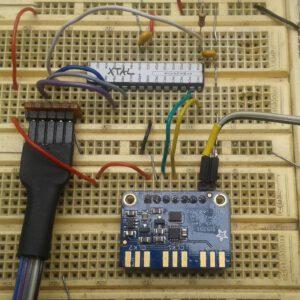Recently a visitor to my QRP-Shop asked me if the Si5351 clock oscillator can be applied as a control oscillator for a VHF transceiver using output frequencies in the range of about 130 to 160 MHz. As I have used the device so far only in the hf range below 30 MHz I started experiments.
The setup
The circuit was very simple: An ATMega328 microcontroller and an Si5351 chip connected via the I2C bus. The bus block rate was set to 100kHz and 400kHz alternatively to exclude I2C issues that are sometimes common when clock rate is inappropriate for one of the devices. The clock rate showed to be not important, just to spoil this article.
As the Si5351 I used a singe chip soldered to a simple breakout board and alternatively an Adafruit Si5351 board which is usable for 5V supply as well. Both showed the same performance.

Software
The oscillator was driven by a software that started generating frequencies from 100MHz to 160MHz using 5MHz steps with 3 seconds hold time with each frequency.
Observations
The signals first were in the expected range concerning frequency accuracy and spectral purity. With reaching approximately 130Mhz they became increasingly impure and got unpredictable in the end when 160MHz came into the range.
As you can see there is a frequency range where the Si5351 more acts like a noise source than as an oscillator.
Approaches made to solve the issue
It is common knowledge that using fractions in the complicated mathematical algorithm that defines the output frequency might lead to impurities and spectral problems with the output signal in an Si5351 oscillator. I have avoided them from the beginning using only integers in my code.
Improper load impedance might be another topic. Thus I terminated the OSC0 output that has been used in this experiment with various loads in the range of 50Ω to 1kΩ. This did not affect the outcome in any way.
Neither alternations in PLL ratio in the software did have any effect.
Results
From these findings I deduce that the Si5351 is a highly problematic device for generating radio frequencies in a VHF transceiver (as well as is it for RF, by the way). I think alternatives should be used, for example high frequency DDS systems like the AD9951 clocked up to 400MHz, even if the costs are much higher and the circuitry is more complicated.
If it is worth the effort to install a 3$ chip (Si5351) that is only 1/10th the price in comparison to a module like the AD9951 but tcauses many problems, every designer should take into careful account.